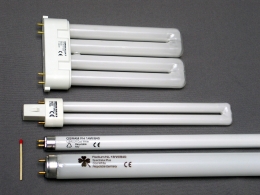These can be recycled at the Snohomish Solid Waste Facilty and the Drop Box Sites. No more than a combined total of 10 household fluorescents or High Intensity Discharge (HID) lamps per load are accepted for recycling. Fluorescents and HIDs should be separated from other garbage and delivered in original containers, or be wrapped or bagged to reduce the risk of breakage while in transit. Do not tape bulbs together.
They are not accepted for recycling in any curbside programs, and not in the garbage.
They are accepted at the Household Hazardous Waste Drop Off Station. Some quantity limits or other restrictions may apply.
It’s a good idea to buy Compact Fluorescent Light Bulbs instead of Incandescent Bulbs. The CF Bulbs last 7 times as long as the incandescent, and save a huge amount of energy
They come in two primary types: tube lighting and CFL (compact fluorescent lighting).
Fluorescent lights can range in size from tubes multiple feet long to the compact bulbs that are about the size of a standard lamp light bulb.
Fluorescent tubes and compact fluorescent bulbs contain significant amounts of mercury that can be inhaled or absorbed through the skin. Mercury is a toxic substance harmful to both humans and wildlife. When fluorescent tubes/bulbs are broken (which happens at landfill sites), the mercury contained within is released, creating a risk of exposure to the mercury vapor. Mercury that is exposed to the air can enter the environment and be deposited in lakes and rivers, where it can be transformed into highly toxic methylmercury. Fish and other wildlife can then ingest mercury passing it up the food chain to humans. Once mercury enters the food chain, it is nearly impossible to remove. The United States Environmental Protection Agency estimates that 600 million fluorescent tubes/bulbs are disposed of annually, with over 80% ending up in landfills.
Here you can find who else will take them back for recycling: https://www.lightrecycle.org/
You do need to find a take back program or drop off location for recycling these items. Many hardware stores such as Lowes or Home Depot will take unbroken Tubes or CFLs.
Recycled materials that can be recovered from the tubes/bulbs are aluminum, glass, phosphor and nearly pure liquid mercury.
Information to deal with a broken fluorescent bulb or lamp: http://earth911.com/home-garden/broken-cfl-clean-up/
No business fluorescents or HID’s are accepted at transfer stations or Drop Box Sites. Call the Haz Waste Drop-Off Station to make an appointment to recycle them. Non-hazardous lamps may be taken to facilities but require prior testing, special preparation, and clearance by the Snohomish Health District (425-339-5250)
